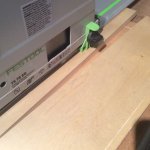Wow-
you make some good points. There are other ways to skin this cat though. In lieu of needing a straight guide board to allow ripping an accurate first edge, I have watched carpenters use a master straight edge (yes, you do need to make that first, and it's good to have one on hand), even a piece of aluminum stock will do. You just slide the edge of the sheet out a bit, clamp on the straight edge and run a flush trim router bit down to get a perfect first edge. Then on to the table saw.
I have never used infeed on a table saw. I am the infeed supports. Use a panel lift to move sheet vertically with perfect edge down, set on front of saw and lower so nose of sheet is resting on the table. Just pick up the back end of the sheet and start walking.
I am only 5'10, 160 lbs and Have been fine ripping MDF 4x8, 9' ply too. Yes it's a bit of work but once you figure it out the strain is minimal and you can process a lot of sheets fairly fast. A power feeder is another great tool for those lucky enough to have one. I have only owned Board Buddy guides but I'll be looking for a feeder soon for my shaper.
But the space needed cannot be argued with. My saw is dead center on a 40' wall, as I work with a lot of 16, 18, occasionally 20' material. I'm happy to have the space, but realize not everyone has that luxury, although with a modern garage bay most should be fine for cutting sheets.
I use both methods (track v table saw) at different times depending on mood, other set ups, stuff in the way, etc. I will say that I find ripping a 4' sheet in half is hard on my back reaching in the two feet to push the track saw. I can't see laying the sheet on the floor and kneeling on it to cut unless on a job in a pinch, as I have to do enough crawling around otherwise, so I'd rather stand and work like an evolved being

I wouldn't give up wither but if I had to the track saw would probably go as I can fins other ways to perform its tasks and did prior to owning one, but I haven't figured out a reliable way to eliminate what the table saw can do for me. To each their own.

